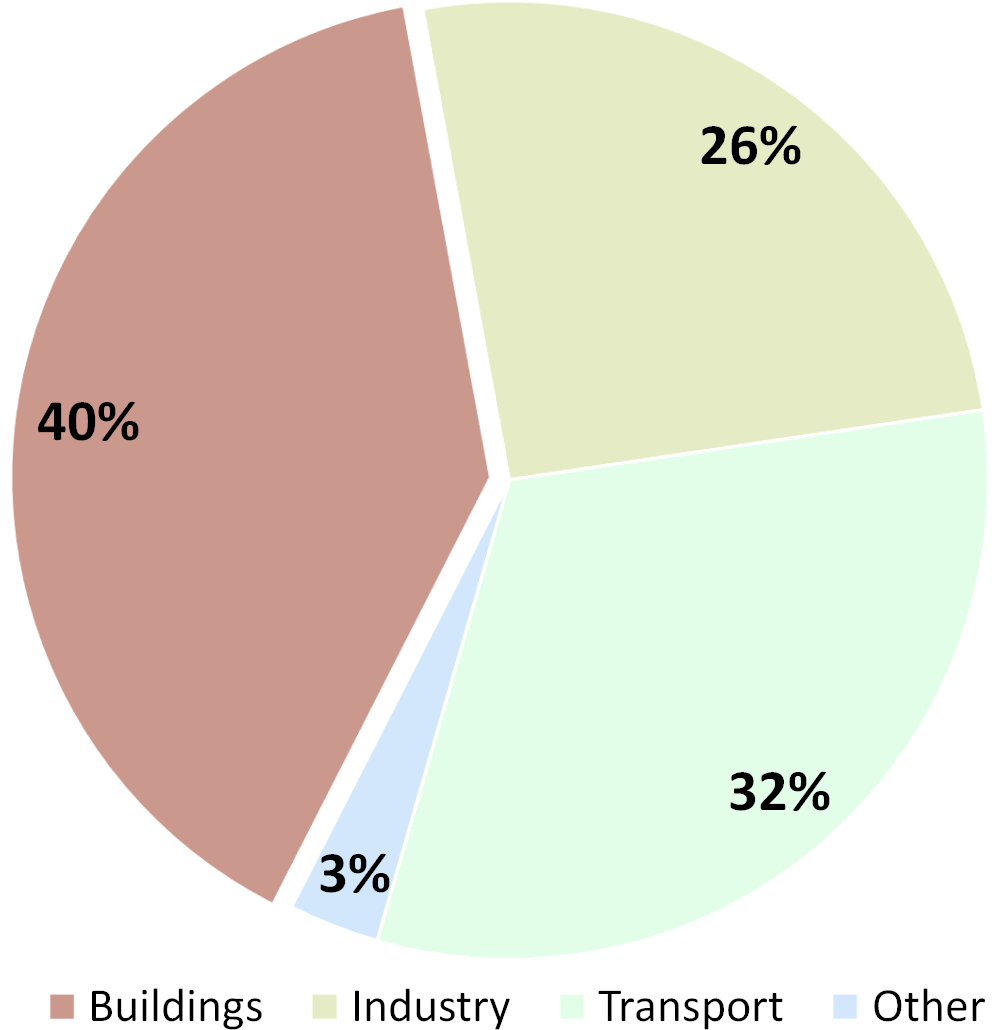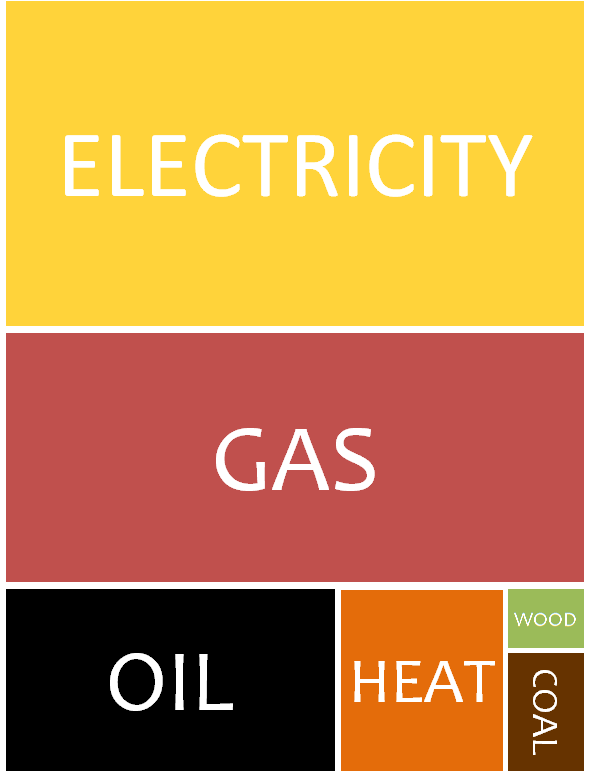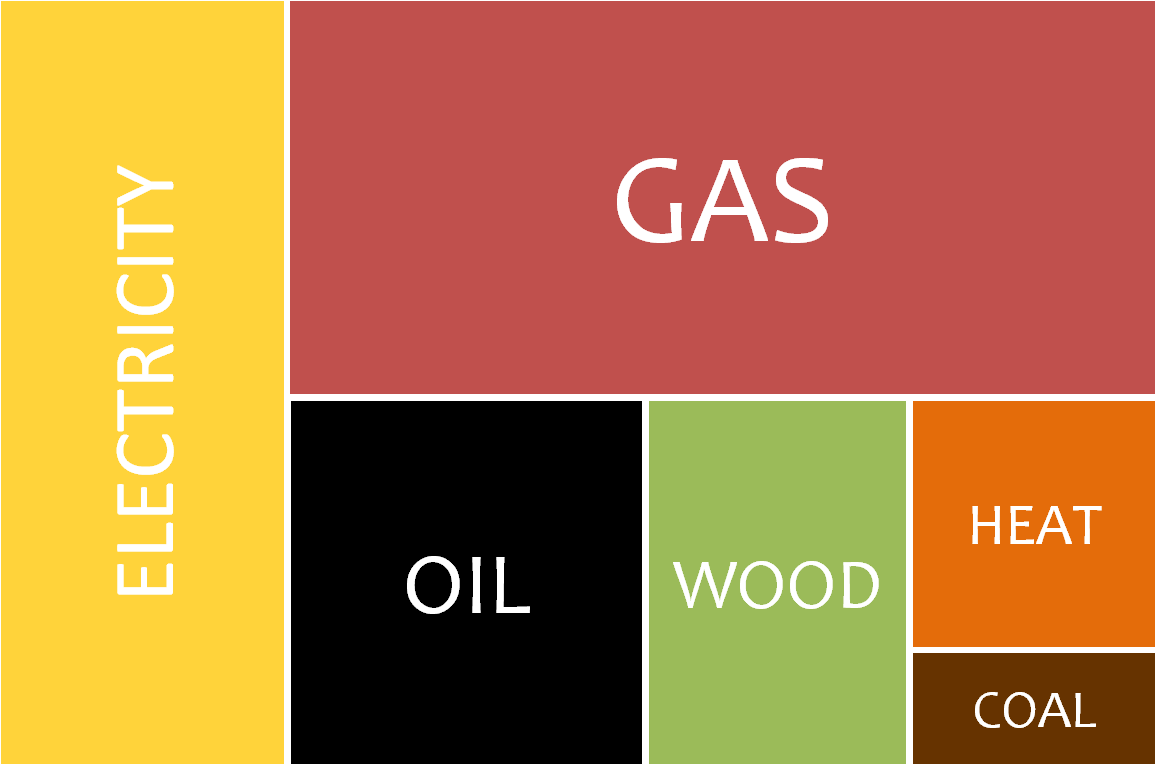Setting the Scene¶
Setting the Scene summarises how the reader can follow the Guide in “Phases” or from the viewpoint of individual “Stakeholders”. Short pages are provided for specific “Problems”. A brief summary of all services, phases and stakeholders is provided.
Chapter Content¶
The Case for ICT-services¶
Energy Efficiency – Buildings – Non-residential Buildings – Residential Buildings – The more insulation you have... – Barriers and obstacles – In-built upgrade potentials
Energy Efficiency¶
All influential organisations consider energy efficiency (EE) the cheapest and fastest option to limit greenhouse gas (GHG) emissions and global warming. It is not only the cheapest option for society as a whole but but also for stakeholders owning, operating and using buildings.
Energy efficiency in buildings is often synonymous for low-carbon construction, insulation and installing expensive hardware. This view is naive. Modern hardware does not always run smoothly - think of your laptop getting slower with time. Causes can be faulty set-ups, systems colliding or users making mistakes. Resolving these problems without stopping you from using the laptop can only be solved with immanently available information, automation and raising the user’s understanding.
Information and Communication Technologies (ICT) are capable of collecting data from various sources and flexibly provide the necessary paths and advice for a wide range of user types in any kind of building.
Whether deploying an EE service is financially feasible predominantly depends on whether consumption and operational savings outweigh the cost. To answer this question, heating and water should be considered as much as electricity to which smart metering is often reduced to.

Final energy consumption in the EU (2012)[1]
Buildings¶
In 2012, the 28 member states of the European Union consumed 1,103,410,100 tons of oil equivalent (TOE). Around 40% are consumed in buildings.
Note
Imagine the Niagara falls for 14 days and 3 hours, but with oil. This resembles the final energy consumption of buildings in the EU.
Investments into insulation and renovation take a long time to pay off. With ICT technology stakeholders can improve operational efficiency as much as EE today.
One immediate benefit of ICT is the detection of on-going wastage. In one example, energy services detected a heating system supplying 250 dwellings re-starting every 10 minutes. In another pilot a subcontractor had bodged the setup of a solar thermal plant reducing output by 30%. Before the projects, these instances had lead to inspections and unnecessary repairs further down the “pipe” which could have been avoided. Even if such “quick wins” are smaller in the majority of buildings, ICT can also help to increase performance at system level, reduce non-technical losses, and for remote reading and switching whilst providing a cheap platform for behavioural changes.
In order for buildings to provide their share in achieving the 20% energy efficiency target by 2020, the renovation rate of public buildings has to reach 3% every year.[2] Over the past years, this rate has not been reached and it is no wonder in times of economic crisis. ICT-enabled services allow payments by contracting future consumption savings and a the services are usually provided by SME. Surely, Energy Management Service (ems) and Energy Decision Support Service (edss) will not achieve immediate savings of 40% but they break even within a few years. Moreover, once the platform has been designed other buildings can be added to the system without much ado.
The Guide will differentiate between non-residential (e.g. public) and residential (e.g. social housing) buildings. Whether the user lives in the building or merely uses it has implications on consumption patterns, user attitudes and control as well as (dis)incentives resulting from regulation / law.
Non-residential Buildings¶
The public sector is to “lead by example” being a key element of today’s national and EU strategies for saving energy, and is mentioned explicitly in the ‘Energy Efficiency Directive’ (EED) adopted by the EU in 2012[3]. Buildings owned and/or managed by the public sector make up around 12% of overall EU building stock and spending of the public sector is 17% of EU GDP; around 40% of the construction turnover is public.[4]

Energy sources in non-residential buildings (EU)[5]
Irrespective of these figures a large share of municipalities have no sufficient policy for reducing operational cost of buildings. No doubt, the portfolio of buildings and resulting requirements are complex. At first sight, offices, schools and sports facilities do not have much in common. Yet they all have obvious usage patterns including off-times. Over the weekend or holidays, however, nobody is in the building able to detect wastage. Without smart-metering additional staff would have to be paid for to ensure optimised operation of buildings.
Another problem is responsibility. Staff does only occupy a small amount of space wishing for the best possible comfort within these boundaries. With or without rules, a compromise is found to make all staff affected as happy as possible. Does your office have a target temperature? With a target temperature there is a certain degree of accountability. Individuals cannot simply complain it to be too cold but many will - so possible - adjust temperature with thermostats, windows and other means.
Janitors and/or facility managers have no means to read the varying temperatures in a building and approaching individuals is a rather unrewarding task. Individuals can be motivated to recognise responsibility for their own space but they cannot foresee possible inefficiencies across the building unless it is explained in simple and graphical form ideally linking cause and effect. Achieving this requires a measurable goal all staff can work towards to at building level and sophisticated services might even allow management for :term:`zone`s.
If you consider implementing the service in a museum do not only look at the references provided to museums. The consumption patterns of a school and a museum obviously differ. However, being in one country they both share regulation, climate and user attitudes. Consider any kind of car in comparison: You can reduce fuel consumption by not breaking at the very last moment possible but lifting your foot sooner. Whether to turn off your engine at a red light, however, depends more on the age of the car than on driving a 4x4 or a sports car. After all, a museum can also be a “modernised glass box” or an Georgian Palace.
Residential Buildings¶
As car drivers, we are very sensitive to costs; we react to the smallest of changes in prices at the pump. Likewise, we make much fuss about changes to public transport ticket prices. Once at home, we seem to take little notice of the cost of energy: Hardly anybody knows how much they pay for heating their homes and how large their electricity bill is.
What is more, there is very little awareness about how changes in day-to-day behaviour affect actual costs. Despite of EU regulation[6], individual metering is not yet the standard for multi-apartment buildings and without transparency most residential users consider the size of their monthly bill for electricity and heating to be outside of their control.
Use of energy tends to be physically “invisible” to consumers. Only the status and comfort of using energy will be visible to residents. Some might consider a reduction of energy consumption as a threat to comfort or status. Such uncertainty about the impact of own behaviour can only be approached with access to information in combination with raising awareness.

Energy sources in residential buildings (EU)[7]
In 2012, around 80% of all energy consumed in households was used for heating (68%) and water heating (12%). The exact distribution of cost, however, depends on the quality of the build as much as the energy source and own behaviour. Various European projects successfully deployed web-portals informing residents in social housing upon water, heating and electricity consumption. These citizens are faced with rising prices and an increased risk of what is now being called “fuel poverty”.[8] An increasing share of the population is affected, for instance, in Germany annual rates of disconnection of households from the electricity grid recently reached nearly 600,000.[9]
Not only families are affected. For instance, public bodies pay for energy consumption in some countries as part of social security. Since implementation cost are low and can be deployed quickly, ICT solutions are of high importance for European councils’ in dire need to reduce their spending.
Hint
The BECA project designed, developed and piloted new solutions to enable sustained reductions in energy consumption across European social housing. This was accomplished by providing usable ICT-based services for Energy Management (ems) and Energy Decision Support Service (edss) directly to tenants as well as to social housing staff.
The project achieved 15% savings for heating, 11% for cold water and 17% for hot water. Savings amount to 570MWh which equals 177 tons of CO2 per year. Financial pay-off is achieved by most stakeholders during the first 3 years. The socio-economic net benefit for the BECA project, extrapolated for ten years, amounts to €1.7Million in pilot buildings alone.
BECA was deployed in seven pilots in seven countries across Europe, Eastern Europe in particular. More than 5,000 social housing tenants were given access to ICT services. 19 organisations participated including relevant government authorities and social housing providers, and coordinated by empirica. The project was supported financially by the European Commission under the ICT Policy Support Programme.
The more insulation you have...¶
An often used argument against ICT is that insulation and good construction will solve the problem as it diminishes any saving potentials by other means. This, however, is only true for the best case scenario (as well as super-modern self-regulating eco-houses).
The best-case scenario assumes that the theoretical value is met at all times and nothing goes wrong or users do not make mistakes. Imagine you recently insulated your home reducing cost dramatically but someone leaves the window open without you noticing: What does this to your bill in per cent? It soon increases it multi-fold as the heating / cooling system is not prepared for such demand. You have already paid for all the insulation but it can only deliver its worth within certain limits. Costs can also come from faulty set-up / operation of heating and solar thermal systems as described in section Buildings above (more will follow...) which combined diminish the theoretical performance.
Warning
Any form of energy wastage in a super efficient building is more expensive than in an old building. A lot of heat/cold can escape through a single open window.
As for self-regulating eco-houses: The authors love innovation and if time and money allows we do recommend constructing these smart buildings with potential to be CO2-negative. However, such concepts often only work in new buildings. Retro-fitting can “only” reach the insulation part but cannot handle regulate themselves. If inhabitants make mistakes the buildings will waste electricity, water and heat unless a smart system can reduce the likelihood, detect and act upon random occurrences.
The more insulation you have...the more information you need.
Barriers and obstacles¶
The 2014 IPCC report on ‘Mitigation of Climate Change’ describes strong barriers, “such as split incentives (e.g., tenants and builders), fragmented markets and inadequate access to information and financing, hinder the market‐based uptake of cost‐effective opportunities.”[10] Many of these barriers apply to a full deployment of ICT-enabled energy services in Europe. The ‘Guide for Replication’ provides the European community with a wide range of recommendations for more than one scenario due to its composition: The reader will be enabled to derive “policy interventions addressing all stages of the building and appliance lifecycles” from stakeholder specific lessons learnt and the step-by-step checklists based on a wide range of pilots.
In-built upgrade potentials¶
Technologies are becoming more integrated and dependent in information. With ICT it will be easier to deploy and ensure efficiency of renewables, the untapped potentials of combined heating-power (CHP) plants_ [#] and local energy storage using mostly existing infrastructure. Using the same systems, partners of the consortia described in this Guide are soon to implement, for instance, a social housing estate almost independent from the gird utilising CHP, batteries and water tanks to store heat; a local distributing heating systems capable of exchanging heat/cold between housing estates, shops and office blocks using only renewables; and extension cards for smart-meters empowering home-owners to demand response (e.g. heat pumps) hereby optimising own production / consumption and energy bills.
This “technology ladder” starts with Energy Management and Decision Support services described in this ‘Guide for Replication’. The information services collect and provide will help to make good decisions about future investments, digital or analog.
Back to Chapter Content
Services¶
The Guide will categorise systems in two services. The edss induces energy savings by human interaction. The ems achieves savings by optimising systems. Stakeholders can choose from a wide range of features most suitable for their building type / portfolio.
Targeting Humans¶
The Energy Decision Support and Awareness Service (edss) delivers energy information and advice to residents, professionals and staff so that they can make savings day by day. In order to avoid wastage and bring about the hoped-for changes in behaviour, hints and guidelines for effectively saving energy are sent to PC, TV or smart phone; alternatively and where preferred, a set of personalised recommendations is presented by letter or in a personal conversation with an energy coach.
Targeting Machines¶
The Energy Management Service (ems) exploits the capabilities of smart metering and installed equipment. Energy management includes actions upon pre-defined events or thresholds and - where possible - self-learning automation of systems to keep the building at an efficient level with changing conditions. Energy management covers any form of production (e.g. boilers, renewables), the distribution process as well as devices consuming energy.
Service Features¶
Each service can have a wide range of different :term:`features`s. A feature can be implement in varying combinations optimised for user groups etc. Features are grouped and described once and examples are provided referring to pilot sites and projects (where varying product names might describe the same feature).
Selected features is described below. How to identify suitable features for your site is explained in Technical set-up, whilst details for implementation can be found in the Technical Documentation
Features for edss¶
edss visualises consumption in ways which are sufficiently user-friendly to attract users to explore their own data. Tenants or staff have access to edss through a web-based platform which allows them to quickly and easily obtain consumption information at numerous time-intervals. Online interaction should not, however, be the only way to approach users. Experience from real-world implementations shows that effectiveness can be increased markedly by combining online with offline modes of interaction.
Monitoring¶
Via sensors installed in the dwelling measuring consumption of heating/cooling, electricity and/or water, data are collected, transferred to a data centre, processed for visualisation and then provided on the user portal. Various presentation modes present monthly and annual consumption patterns as graphics covering monetary estimates for the bill and technical units (e.g. kWh, m³).
Benchmarking¶
Data already recorded can be benchmarked along various dimensions. Users are invited to compare their current consumption patterns to the data from earlier points in time or to data from reference groups, e.g. average over all dwellings in the same building. Visualisation through bar charts and statistics such as percentage decreases/increases can be provided.
In the residential domain, peer comparisons appear especially suited. This consists of comparison of energy consumption levels between similar-sized households. This information may include neighbours within of similar size in the same climate zone. It enables participants to see if they use more or less electricity than their peers, without disclosing confidential data (averages rather than figures for individual neighbour dwellings are being used).
Examples are Westerlo, Angers, North Italy
Personalised recommendations and advice¶
Zones (e.g. a floor) and individual users (e.g. tenant with ID) can be provided with recommendations and advice tailored to their individual consumption profile. This content is generated automatically. The software can pick-up on recent wastage or in areas where there is room for improvement. An app can then provide the user with means and advice on how to affect the next bill. However, no recommendations should be given if there is nothing to improve to avoid users “automatically” ignoring the feature.
Alerts¶
edss can also send alerts informing professional and/or novice users about unexpected data. Professional users are informed about leakages and interruptions in the data recording to avoid damage to the building and further loss. Smarter alerts can also detect behavioural issues of users. For example, a high heating consumption over a longer period which is not combined with an increase of the inside temperature can show an abusive opening of the windows. Tenants/staff in dwelling/zone are then advised about ventilation policies.
Self Assessment¶
A self-assessment enables users to develop realistic targets for their personel energy savings. This makes them active participants of the system rather than just passive actors receiving feedback. The simplest form is a target for their monthly bill to be displayed as a line in the chart on the portal. If the resulting daily “allowance” is massively overreached, alerts can be send. In combination with questionnaire, the portal provides the tenant with options for saving potentials including advice on whether replacing certain equipment might be cost-efficient.
Reports¶
Users cannot be expected to visit the portal (some might not have a computer) on regular basis and automatic messages might not be possible for technical reasons etc. In such cases automatically generated reports can help. A standardised format can be downloaded from the portal for print and/or send via email. In non-residential buildings it can be put on the public board. In residential buildings personalised reports can be delivered as mail or personally by the Energy Coach if saving potentials could be discussed.
Examples are Moulins, Extremadura, Solingen
Meetings / Courses¶
As part of the initial “recruitment” of users, at least one meeting should be organised to explain the service. Such a concept, can also be used to identify champions who can help their neighbours i.e. becoming promoters of the system and also transmitters of practical knowledge to those users who are hard to reach directly by, for instance, the housing provider.
Energy Coach¶
The ‘Energy coach’ is to help users understand energy efficiency and how it relates to the information provided by edss and the resulting energy costs. Activities of the coach include personal discussions; help with using the installed equipment and with the online portal; etc. prompted by a request from the user. With the necessary permission, couches can act proactively if they see high consumption on Reports or notified by Alerts. If funds are not sufficient for an Energy Coach regular Meetings / Courses (e.g. monthly) can be organised to give individuals opportunity to ask questions.
Examples are Moulins, North Italy, Karlsruhe
Features for ems¶
ems
Manage Consumption¶
Smart metering can also enable building operators and/or utilities to increase energy efficiency by centrally monitoring and managing their customer’s energy consumption. This can bring significant benefits in system efficiency and help achieve sizeable energy savings. Based on measured and monitored energy consumption, supply quality (i.e. outages, surges and sags, for instance) and event alarms, the power management system can suggest or initiate schemes for reducing energy consumption.
One application area are district heating systems delivering heated water to buildings, which are known to be more difficult to meter and control than individual dwelling heating. Once smart technologies are in place, these systems can automatically carry out partial switch off – boilers, pumps etc. – depending on demand parameters set by tenants. Tenants can arrange that temperature in individual rooms or throughout the dwelling are reduced during the night and during absence from the dwelling.
Peak Shaving¶
Peak shaving (often referred to as demand response) refers to the fact that major waste of energy and unnecessary CO2 emission continues today through networks meeting very uneven loads, often having fossil fuel power stations take on peaks then running idle (but not without emissions) in the interim. Peaks arise through the very uneven load curve over a typical 24 hour period, with very significant peaks arising from residential behaviour (e.g. cooking periods in the early evening) and non-residential buildings (e.g. use of AC around noon). Any method to shift time of use of energy (e.g. electricity) from peak use periods to times of lower demand makes energy provision more efficient.
Energy management in the residential environment can make a contribution to evening the load over time and in particular “shaving” peak consumption. This approach is based on the latency periods, heat storage capabilities or indifferent delivery timing of a number of domestic appliances from fridges to hot water heaters. The performance of heating and cooling devices with good insulation and therefore appreciable temperature maintenance characteristics degrades little over short periods of time. Quality of service to customers (household satisfaction with water temperature, fridge temperature etc.) is unlikely to suffer when these devices are cut off from the electricity supply for periods of many minutes.
As the strongest peaks are unpredictable and typically short term; response must be automatic and according to preset rules defined by the professional or utility. Such automation means that, through remote controllers in appliances, for instance an AC or electric heating thermostat is set to turn down or off during peak periods. ems enabling such dynamic, intelligent peak shaving can thus contribute significantly to energy efficiency in the residential and non-residential sectors.
Early Default and Maintenance Management¶
The aim of early default and maintenance management is to utilise (big) data from the surveillance of the systems and to be able to react and solve the problems more rapidly than before. For example, see the screenshot on the right which is from the Darmstadt BECA site; it shows how the adapterm system works: If abnormal values are identified, they can easily be traced back to their point of origin allowing for quick countermeasures to be taken and / or the overall setting of the heating system to be optimised.
In Catalonia, the central solar system is equipped with a system of early default detection and maintenance management. If the production of the central solar system remains very low or is equal to 0 during three consecutive days, an email is automatically sent to the maintenance company as well as to the service provider. Thus, a revision of the system is possible and the problem can be solved within 3 days.
Renewables¶
Smart metering can be used to integrate the growing number of embedded renewable generators, such as wind and photovoltaic. Smart Metering systems can readily be set up to measure exported power, when the housing unit use less power than it generates. Such systems can also measure the output of the generator and supply this data to the energy company to provide a complete picture of the generator’s performance.
Modern district heating plant appropriate for use in social housing is available fired with renewable energy sources and built as combined heat and power CHP to provide additional, cost-effective power generation. Manufacturers of these and other decentralised energy supply installations like solar panels already provide ICT components for systems monitoring and control – products are equipped with up-to-date measurement and control devices and local screens which show current operation parameters.
Storage¶
The extension of renewable management and peak shaving / demand response would be to actively manage the own production as well as utilise price differences in the grid. Localised electricity storage can save some of the energy supplied in abundance during sunny noons or windy evenings to reduce costs and to avoid peaks for the grid by supplying energy locally from storage.
Energy can also be stored as heat and cold by, for instance, heating up the building or a water tank with cheap energy to avoid this effort when energy supply is more critical. There will be a few losses but the opportunity cost might be lower locally (lower prices) but also on grid level (avoiding back-up plants and turning off power plants).
This feature has not yet been applied by the pilot sites as this was not the area of the projects. However, several sites are doing research in the domain of local storage and advanced demand response. Should the opportunity arise, will this Guide be extended by the documentation for such projects and services.
Back to Chapter Content
ICT Terminology¶
Requirements¶
A requirement is any technical, organisational or user specific request. Requirements are collected using workshops and questionnaires and should be collected from all user groups as they might have different needs. Requirements are prioritised to identify critical and to organise work. Later in the process, the system can be compared against the list of highly prioritised requirements and if all are covered the tester can be confident that (at least from this view point) the system is fully functional.
The Guide offers a comprehensive list of almost 500 requirements collected from 28 pilot sites traceable by an ID. The necessary set is listed with each Use Case and Process Model so replicating stakeholders know what to look out for.
Use Cases¶
Each use case describes one particular scenario in which the user interacts with the system. A use case is described with a summary and the flow of events. Any precautions taken to respond to mistakes by either the system or the user which do not resemble the base flow of events will be described as well. Each use case has a unique ID and name. Each use case matches exactly one process model.
Use cases and process models were developed in parallel: Input gathered from process models was implemented in the use cases and vice versa. Either presents the full complexity of the scenario across all pilot sites implementing this particular scenario. Hence, certain sites might not cover all steps or implement the flow slightly differently.
Note
Your system does not have to implement the entire complexity to deploy a certain feature. Some steps cover specialised elements and can be “cut out” or come with an “upgrade” later.
The Guide offers a comprehensive list of 49 Use Cases (with Process Models and Requirements) collected from 28 pilot sites traceable by an ID.
Process Models¶
The primary goal of Process Models is to provide a notation that is readily understandable by all business users, from the business analysts that create the initial drafts of the processes, to the technical developers responsible for implementing the technology that will perform those processes, and finally, to the business people who will manage and monitor these processes. Thus, BPMN creates a standardised bridge for the gap between the business process design and process implementation.
Common Framework¶
The technical documentation for the projects SMARTSPACES, BECA and esesh uses one common framework to describe requirements, use cases etc. Herby the Guide achieves to summarise similarities of systems for residential and non-residential buildings.
Back to Chapter Content
Structure of the Guide¶
The Guide avoids lists of definitions. Instead, all terms in italic and visible as links are described in the Glossary. Abbreviations with a dotted line show the full meaning once hoovered upon.
Tip
To quickly check a reference, hoover over a term visible as a link and press on the mousewheel.
The Guide can be read from three perspectives:
- Chronologically with all detail related to a project (Phases)
- From the view of one stakeholder with selected detail (Stakeholders)
- Issue focused with detail only referencing this one issue (Problems)
Pilot sites are provided as References including description of the service, success and include the portal where possible. Full complexity is described in Technical Documentation and Legal Documentation.
It is easy for different stakeholders to communicate and exchange as the Guide wil use the same headings, in fact, the same text. This approach ensures that any update is automatically available everywhere!
Back to Chapter Content
—— Footnotes
| [1] | Own compilation, Source: eurostat |
| [2] | See, among others, Energy Performance of Buildings Directive (EPBD) and Concerted Action deviced to support countries in their goal for renovation. |
| [3] | Sources for figures: Ecorys, Ecofys and BioIntelligence (2010): Study to Support the Impact Assessment for the EU Energy Saving Action Plan. The estimate is based on the assumption of 5 m² of public buildings per citizen, translating into a total floor area of public buildings (excluding social housing) in the EU of 2.5 billion m². The total floor area is 21 billion m²; COM(2011) 15: Green Paper on the modernization of EU public procurement policy: Towards a more efficient European procurement market; ICT for a Low Carbon Economy Smart Buildings, July 2009, Findings by the High-Level Advisory Group, the REEB Consortium ‘On the Building and Construction sector’. |
| [4] | Energy Efficiency Directive (2012/27/EU), amending Directives 2009/125/EC and 2010/30/EU and repealing Directives 2004/8/EC and 2006/32/EC |
| [5] | ©empirica 2014, Sources: Odyssee-Project, eurostat |
| [6] | See in particular, Article 9-11 of Energy Efficiency Directive (2012/27/EU) |
| [7] | ©empirica 2014, Sources: Odyssee-Project, eurostat |
| [8] | Brunner, Spitzer, et al. (2011). Experiencing fuel poverty. Coping strategies of low-income households in Vienna/Austria. Energy Policy. |
| [9] | Die Welt (29.04.2012). Strom ist für viele Deutsche unbezahlbar geworden. |
| [10] | IPCC (2014), Mitigation of Climate Change – Summary for Policy Makers, p. 26. |
| [11] | The IEA considers CHP capacity could double in most Western countries by 2030: IEA (2011) Co-generation and Renewables: Solutions for a low-carbon energy future |













